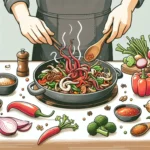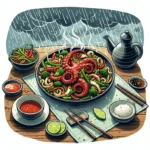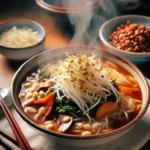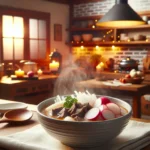Imagine sitting down to a steaming bowl of Korean beef short rib soup, or Galbitang, on a chilly night. The aroma wafts through the air, promising warmth and comfort. This dish is more than just a meal; it embodies tradition and family. As we explore its rich origins and history, you’ll discover the essential ingredients that make Galbitang a beloved classic. From step-by-step cooking instructions to tips for enjoying this hearty soup, get ready to embark on a culinary journey that celebrates the flavors of Korea. Let’s delve into the art of crafting the ultimate Galbitang, where every spoonful tells a story!
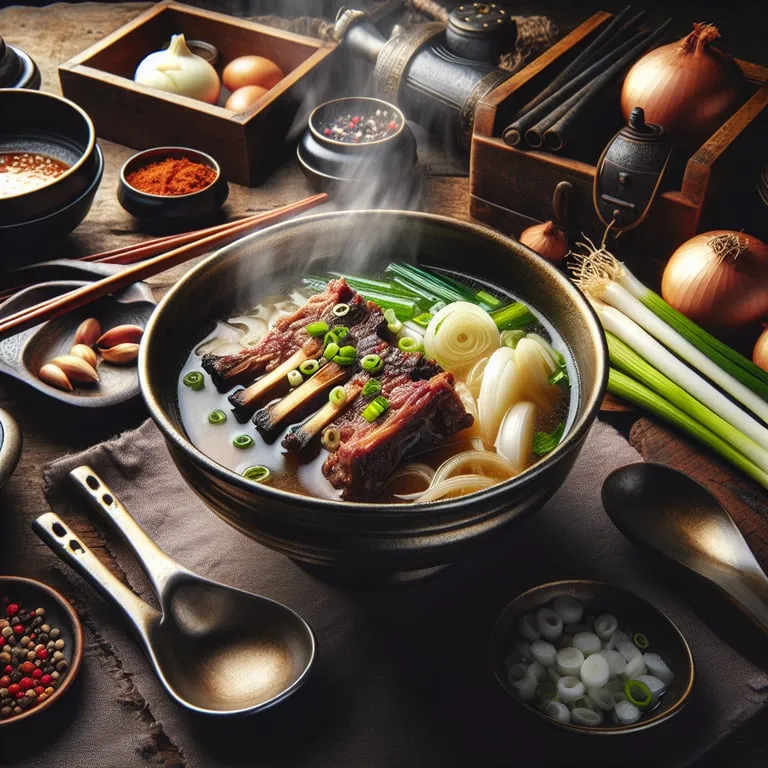
Origin and History of Galbitang
Galbitang, a beloved Korean dish, is not merely a bowl of soup; it represents a tapestry of culture and history woven into every noodle and rib. This hearty dish, traditionally made with beef short ribs, is a paragon of Korean cuisine that transcends generations. 🌏✨
Historical Roots
The roots of Galbitang can be traced back to the Goryeo Dynasty (918-1392), where it was a staple for nobility. Fast forward to the Joseon Dynasty (1392-1910), and you will find traces of beef ribs making their way into the royal court’s cuisine, celebrated for their tender texture and rich flavor. As society evolved, so did the culinary practices, leading to more accessible versions for the masses. By the 20th century, Galbitang had become a family favorite, often served during celebrations and special occasions. Its name, translating to “short rib soup,” reflects its essential ingredient and straightforward preparation, embodying the cozy warmth of a home-cooked meal. 🍖🥣
Nutritional Benefits
What makes Galbitang remarkable is not just its exquisite flavor but also the nutritional benefits it provides. A typical serving contains approximately 300-400 calories, offering a rich source of protein with over 30 grams per portion. The broth, simmered for hours, releases collagen from the bones, contributing to skin health and joint support—an unspoken testament to the holistic approach in traditional Korean cuisine! 💪😊
Cultural Significance
Additionally, this dish holds cultural significance that goes beyond the dining table. Families gather over bowls of Galbitang, sharing stories that often revolve around the preparation of the dish. Recipes are passed down, modified, and personalized, each reflecting the tastes and preferences of individual households. This soup has a unique power to conjure memories and foster connections—what better way to preserve heritage than through food?
Seasonal Adaptability
The use of essential ingredients, notably garlic, green onions, and sesame oil, not only enhances the soup’s flavor profile but also showcases Korea’s agriculture. In a country where seasons dictate the availability of ingredients, Galbitang’s evolution is a beautiful example of adaptability and respect for nature’s bounty. It exemplifies the South Korean practice of balancing flavors, where sweet, salty, and umami dance together in delicious harmony! 😍🍜
Comparison to Galbi
Interestingly, Galbitang is often mistaken for another similar dish, Galbi (grilled spareribs), often enjoyed in summer BBQs. However, the warming nature of Galbitang makes it a staple during colder months, offering a perfect remedy for chill and fatigue. Isn’t it fascinating how foods adapt to their environmental context? 🌬️🥶
As one savors this timeless dish, it is essential to understand that each sip of Galbitang holds stories of resilience, evolution, and a community deeply intertwined with its history. It’s not just a meal; it’s a celebration of life, history, and familial bonds. Each bowl of Galbitang is, therefore, not only a delight for the taste buds but also a warm embrace of culture and tradition that nourishes the soul. ❤️
Essential Ingredients for Perfect Galbitang
To truly master the art of Galbitang, one must understand the significance of each ingredient that comes together to create this heartwarming dish. The key components work in harmonious synergy to produce an aromatic broth filled with rich flavors and nutritional benefits. So, let’s dive into the essential ingredients that elevate Galbitang from simply being a meal to an unforgettable experience! 🌟
1. Beef Short Ribs
The star of the show! For the best taste, you should opt for well-marbled short ribs—approximately 2 to 3 pounds should suffice for a hearty serving. The fat content dissolves during cooking, creating a rich, succulent broth. When selecting your beef, look for ribs with a nice balance of lean meat and fat. It’s generally recommended to choose boneless or bone-in, but bone-in offers a deeper umami flavor. The bones infuse the soup with collagen, giving it a luxurious texture! 😊
2. Water
The often-overlooked hero! Aim for about 8 cups of cold water to form the soup base. Using cold water helps draw out exquisite flavors from the beef. Some chefs swear by using broth for extra depth, but nothing quite compares to the purity of water infused with nature’s goodness through the cooking process. The magic happens as the flavors meld together, so don’t rush this! 💧
3. Aromatics
A melody of natural flavors! Essential aromatics include 1 medium onion, 1 head of garlic, and a small piece of ginger. Whole garlic cloves (about 10) add robust flavor while infusing the broth with health benefits. Meanwhile, a thumb-sized ginger slice lends a warm, spiced note to the dish. For the onion, cut it in half—its sweetness will mellow and enrich the broth over time. Aromatics enhance the dish, transforming your kitchen into a fragrant haven! 🧄✨
4. Vegetables
Getting colorful! Traditional Galbitang often features Korean radish (mu) and green onions. About half a medium-sized radish add a subtly sweet contrast and a hearty texture, while roughly 3-4 green onions add brightness and warmth. They can be chopped and thrown in during cooking or added as a fresh garnish. Other vegetables you might consider are carrots or mushrooms for additional flavor layers! 🌈
5. Seasonings
To satisfy your palate! The basics boil down to sea salt, black pepper, and soy sauce. Typically, you’ll need about 2 teaspoons each of salt and soy sauce, but remember to adjust according to your personal taste preferences! 🧂✨ A sprinkle of black pepper adds a gentle kick, balancing the sweeter notes of the radish and beef.
6. Garnishes
It’s all about presentation! Freshly chopped green onions provide that delightful crunch, while sesame seeds sprinkled on top add a nutty finish. A drizzle of sesame oil can also slightly enhance the flavor, lending a richness that beckons you back for a second serving. Have some kimchi or pickled vegetables on the side for a tangy bite, perfect to use as a contrast to the rich soup! 🌿🍚
Each ingredient in Galbitang plays a specific role, coming together to create a symphony of flavors and textures. From the juicy tenderness of the beef short ribs to the aromatic embrace of garlic and ginger, they make every slurp a new adventure. Sharing this dish not only nourishes the body but also warms the heart, drawing loved ones together around the table. This ultimate comfort food is a reflection of tradition and a celebration of its home-cooked essence! 🍲❤️
Step-by-Step Cooking Instructions
To create the most exquisite Galbitang, a few meticulous steps are essential to capture the essence of this beloved Korean beef short rib soup! 🌟 Let’s dive into a rich culinary journey that will elevate your cooking game!
1. Preparing the Ingredients (15 minutes)
Gather the following essential ingredients:
- 2.5 pounds of beef short ribs (cut into 2-inch pieces) 🥩
- 10 cups of water or enough to cover the ribs
- 1 medium onion, halved 🌰
- 4 cloves of garlic, crushed 🧄
- 1 piece of ginger (2 inches), sliced
- 2 green onions, chopped
- Salt and pepper, to taste 🧂
- Optional: Korean radish (mu) slices for added flavor
2. Soaking the Ribs (30 minutes)
To enhance the depth of flavor, start by soaking the beef short ribs in cold water for about 30 minutes. This step will help remove the excess blood and impurities, resulting in clearer broth and a more refined taste! 💧 Once soaked, drain the ribs and rinse them thoroughly.
3. Boiling the Ribs (1 hour)
In a large pot, combine the soaked ribs and 10 cups of water. Bring it to a rapid boil over high heat. As the water heats, you may notice impurities surfacing—skimming this foam off will ensure a cleaner broth! After achieving a vigorous boil, reduce heat to medium-low, cover the pot, and let it simmer for approximately 1 hour. The meat should become tender and juicy! 🍲
4. Adding Aromatics (20 minutes)
After an hour, add the halved onion, crushed garlic, sliced ginger, and if using, the radish slices to the pot. These ingredients will infuse the soup with delightful aromas and a subtle sweetness. Continue to simmer for another 20 minutes while the flavors meld beautifully! 🌿
5. Flavoring the Broth (10–15 minutes)
Once the aroma begins to envelop your kitchen, it’s time to season. Add salt and pepper to taste, ensuring the broth is perfectly balanced. This is essential for the overall flavor profile of your Galbitang. Adjust the seasoning gradually; a little pinch goes a long way! 😋
6. Final Touches and Garnishing (5 minutes)
Remove the pot from heat and discard the onion, ginger, and garlic! For a fresh touch, sprinkle the soup with chopped green onions just before serving. This not only enhances visual appeal but adds a refreshing crunch as well! 🌈
7. Serving the Galbitang (Allure the Senses!)
Traditionally, Galbitang is served with a side of white rice and an assortment of banchan (side dishes). Ladle the rich broth into individual bowls, ensuring generous portions of tender meat for each guest to enjoy! A sprinkle of sesame seeds can add a nutty finish, while a dash of gochugaru (Korean red pepper flakes) provides an optional kick!
By following these precise steps, you’ll create a Galbitang that resonates with authentic Korean flavors and delights your senses. Everyone will appreciate the delightful warmth and comfort that this soup provides, making it perfect for gatherings or a cozy family meal. Bon appétit! 🍜
Tips for Serving and Enjoying Galbitang
When it comes to savoring the rich, soul-warming flavors of Galbitang, every detail of the presentation and experience can enhance your enjoyment! Here are some insightful tips that will not only elevate the taste but also create a delightful dining atmosphere.
1. The Perfect Serving Temperature:
Galbitang is best served piping hot! Ideally, the soup should be at a temperature of around 70-80°C (158-176°F) when it reaches the table. This ensures that the succulent beef ribs remain tender and the broth exudes its full umami flavors. To achieve this, consider using a thick, heavy pot that retains heat well. If you’re using a clay pot, it will help keep the soup warm longer—just be careful when serving, as it can get quite hot! 🔥
2. Bowl and Utensil Selection:
Choosing the right bowls can make a significant difference in the dining experience! Traditional Korean bowls—often made of stoneware or ceramic—add an authentic touch, while also helping to maintain the soup’s heat. Small, deep bowls are ideal for serving Galbitang, allowing diners to scoop up both soup and meat easily. Don’t forget to provide long chopsticks and spoon for an authentic experience. The combination of these utensils creates an engaging and traditional vibe! 🍲✨
3. Accompaniments are Key:
To truly appreciate Galbitang, consider serving it alongside classic Korean side dishes known as banchan! Some popular choices include spicy kimchi, pickled radishes, or seasoned spinach. These bright flavors will brilliantly contrast the rich soup, offering a well-rounded meal. Plus, the variety adds fun to the dining table! Aim for at least three different banchan items to enrich the palate. 🥬🥒
4. Garnishing with Fresh Herbs:
A final touch that can elevate your Galbitang is the addition of fresh herbs. Sprinkling finely chopped scallions or cilantro just before serving will brighten the dish and add layers of flavor. Not only do they enhance the aesthetic appeal, but they also invigorate the senses. Consider adding a pinch of Korean chili flakes (gochugaru) for a splash of color and a hint of heat! 🌿🌶️
5. Pairing with Rice:
Galbitang is traditionally enjoyed with steamed white rice, allowing you to soak up the flavorful broth. Serve sticky short-grain rice in a separate bowl alongside the soup. A common practice is to place a spoonful of rice into a bowl of Galbitang, letting it mingle with the savory broth before enjoying it all together. The simple, comforting combination is a staple in many Korean households! 🍚💖
6. Sharing the Experience:
Food is often best when shared, and Galbitang is no exception! Encourage family-style serving where diners can help themselves from a communal pot. This not only fosters a sense of community but also allows everyone to enjoy the rich flavors and tender beef together. The laughter, conversation, and camaraderie that ensue create moments to cherish! 🥳🍽️
7. Savor Consideration:
Take your time! Sit back and enjoy the symposium of flavors with each spoonful. Galbitang is hearty and fulfilling, with a depth that unfolds gradually. Slow eating allows for an appreciation of the nuanced tastes from the marbled beef ribs to the aromatic broth simmered with garlic and radish. Consider pairing with a refreshing drink, such as traditional Korean sujeonggwa (cinnamon dessert drink) or a light, cold beverage to cleanse the palate in between bites. ☕🥗
8. Ideal Occasions:
Galbitang shines at gatherings—whether it’s a festive lunar new year or a cozy winter night with loved ones. It’s the perfect remedy for chilly evenings, special family dinners, or as a comforting dish when someone is under the weather. Understanding the cultural context can enrich your appreciation, making it not just a meal but an experience steeped in tradition! 🎉❤️
By incorporating these tips, the experience of enjoying Galbitang will transcend the mere act of eating—it becomes a joyful culinary adventure! This comforting bowl of soup awaits you, laden with rich flavors and heartwarming nostalgia, ready to unite friends and family around the table.
In conclusion, galbitang is more than just a comforting bowl of soup; it encapsulates the rich heritage and vibrant flavors of Korean culinary tradition. Each spoonful tells a story, inviting you to explore its origins while embracing the warmth it brings to the table. So, as you set out to create this delectable dish, remember to savor every moment—from gathering the essential ingredients to sharing it with loved ones. Galbitang isn’t just a meal; it’s an experience that fosters connection and appreciation for the artistry of cooking. Embrace the journey, and enjoy the delicious rewards that await you!




